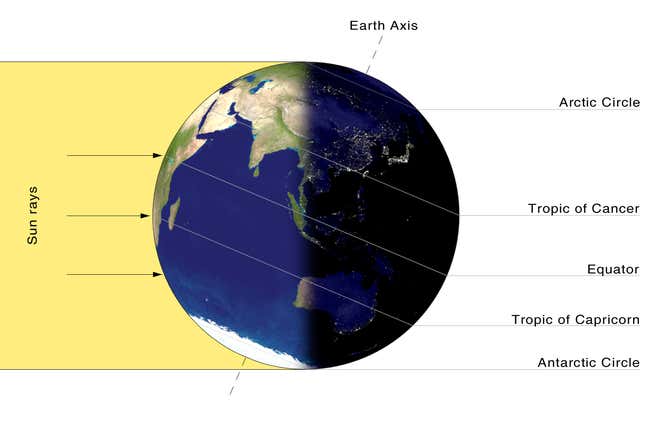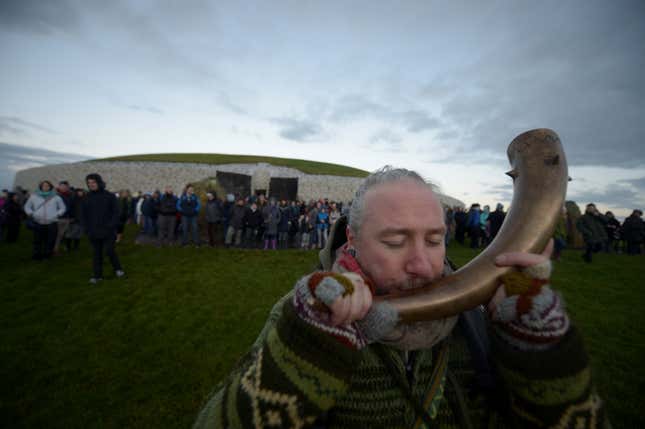For most of the world’s population, this Thursday (Dec. 21) will be the shortest day and longest night of the year as the winter solstice kicks in.
The day marks the beginning of winter for the northern hemisphere when the sun’s rays are directly over the Tropic of Capricorn, the southernmost latitude (23.5° S) where the sun can be directly overhead. The winter solstice will happen this year at 4:28pm GMT. (In New York, it will take place around 11am, and around midnight in Hong Kong on Dec. 22.)
The winter solstice has been a spiritually and scientifically important day since ancient times for people around the world the mark the changing of seasons. Today, people divide the seasons using advanced technological tools, but still celebrate the day as part of their cultural traditions.
What is winter solstice?
The word “solstice” originates from the Latin word solstitium, a portmanteau of sol and stit, to mean ”standing sun.”
The reason for the shorter daylight on the winter solstice is related to how the Earth travels around the sun. The Earth sits at a tilt of 23.5°, so its hemispheres, divided by the equator, receive different amounts of sunlight. In December, when the northern hemisphere is tilted away from the sun, countries north of the equator enter winter. The winter solstice marks the northern hemisphere’s most extreme angle from the sun. Conversely, the winter solstice for countries in the southern hemisphere, like Australia and New Zealand, is in June.

However, just because it’s the shortest day of the year doesn’t mean it’s the coldest time of the year, since temperature also depends on landforms and oceans that absorb and release heat energy. The shortest day doesn’t correspond to the earliest sunset either, according to the National Geographic, because of the difference between the human and sun clocks. The 24-hour cycle that humans abide by doesn’t always match the solar noon, when the sun is at the highest point in the sky. This discrepancy actually means that sunset on the day of the solstice is a few minutes later according to human clocks than sunset earlier in the month.
Traditions around the world
People have celebrated the winter solstice since the ancient times. Some still gather to mark the arrival of winter, or to observe the ancients’ wisdom in blending astronomical events with architecture.
Newgrange
In Ireland, a huge tomb-shaped stone known as Newgrange has more than 5,000 years of history. In the 1960s, archeologists found that during the solstice, the sun’s rays traveled across a 19-meter-long (62-foot) passageway, through a perfectly positioned window, to a chamber where the ashes and bones of the dead were placed. Today, people will participate in an annual lottery so they can gather outside the tomb and bang drums to greet the sun.

Stonehenge
The assemblage of giant rocks located in Wiltshire, England, built around 3000 BC to 2000 BC, is famous for its solstice celebrations. The prehistoric monument is carefully aligned for a clear sight of sunset on the winter solstice. In 2016, thousands of people gathered there to celebrate the “rebirth” of the sun by playing trumpets and drums.

China
In China, winter solstice is known as dong zhi, meaning the winter’s arrival. In ancient times, the day had often been considered as important as Lunar New Year, according to state news broadcaster CCTV. People often make food symbolizing harmoniousness and reunion, such as glutinous rice flour balls in southern China and dumplings in the country’s northern region. The day also marks the rising of yang, masculine and positive energy, making it an ideal time to adjust one’s diet to store yang energy, which is believed to help fight against illness.
Japan
In Japan, the holiday is known as Touji. In Japanese tradition, taking a hot bath with the citrus fruit yuzu on the winter solstice is believed to help ward off colds. In 2016’s solstice celebration, six preschool students took a yuzu bath in Japan’s southwestern Hyogo prefecture with around 50 citrus fruits. The tradition has extended to the country’s favorite animal, the capybara. Last year, a zoo in Japan’s eastern Shizuoka prefecture arranged a hot yuzu tub for the animals on the winter solstice.
